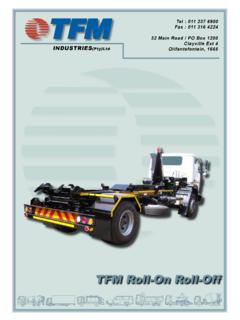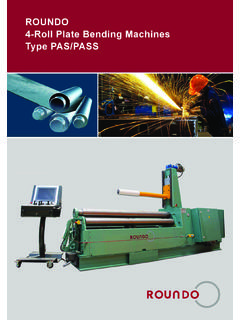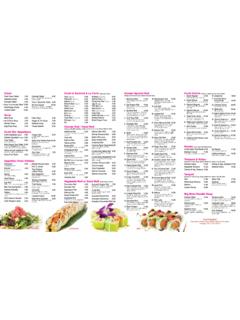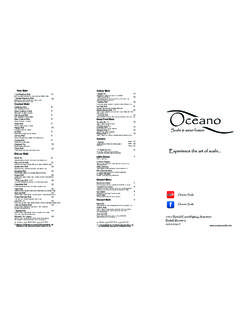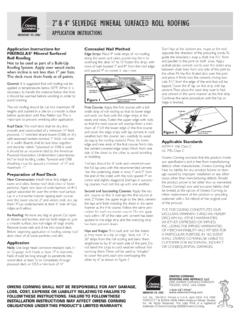Transcription of RR862 - Safe transport of roll cages
1 Health and Safety Executive safe transport of roll cages Prepared by the Health and Safety Laboratory for the Health and Safety Executive 2011 RR862 Research Report Health and Safety Executive safe transport of roll cages N Day (Hons) Health and Safety Laboratory Harpur Hill Buxton Derbyshire SK17 9JN Loading vehicles and transporting goods on the road may be the most dangerous work activity carried out by many companies operating in the UK. Previous research carried out for HSE by HSL highlighted the risks to operators and other parties when goods are transported on the roads and, following the publication of the research, industry stakeholders expressed concern regarding the current methods of loading and securing roll cages in single and double-deck trailers. The profile of UK freight transport has changed significantly over the last fifty years, not only in terms of the quantity of goods moved, which has increased significantly, but also the mode of transport .
2 The majority of the raw materials and goods used or sold by UK businesses are now transported by road rather than rail, and the road haulage industry transports a highly diverse range of goods, including food and agricultural products, bulk liquids, car components, container transport , express parcels, furniture removal, heavy haulage, and livestock. Goods such as food, drink, tobacco products, toiletries and household goods, which are often transported in roll cages , comprise over half of all goods transported on the road. This report seeks to give an overview of current practice, legislation and guidance, identify the problems associated with transporting roll cages , and offer practical information on good practice for loading and securing roll cages for safe loading, transport and unloading. This report and the work it describes were funded by the Health and Safety Executive (HSE).
3 Its contents, including any opinions and/or conclusions expressed, are those of the author alone and do not necessarily reflect HSE policy. HSE Books Crown copyright 2011 First published 2011 You may reuse this information (not including logos) free of charge in any format or medium, under the terms of the Open Government Licence. To view the licence visit licence/, write to the Information Policy Team, The National Archives, Kew, London TW9 4DU, or email Some images and illustrations may not be owned by the Crown so cannot be reproduced without permission of the copyright owner. Enquiries should be sent to ACKNOWLEDGEMENTS The author wishes to thank all those to contributed their time and expertise to this research project, in particular the HSE and Local Authority inspectors who identified companies willing to contribute their experience.
4 Ii KEY MESSAGES roll cages falling from delivery vehicles and drivers falling from their vehicles during loading and unloading are the two most significant factors in accidents involving roll cages in the UK. Over a four-year period, 59 reportable accidents in these two categories were identified. 18 accidents were defined as Major . Aside from the human cost of accidents, even near-misses involve a significant cost to companies in terms of product, equipment and vehicle damage, and damage to reputation and business relationships. In both categories, the initiating cause of the accident was often an uncontrolled movement of one or more of the cages during loading or unloading. Movement of the cages in transit may be a contributory factor to uncontrolled movement of the cages during unloading.
5 cages that have moved in transit may be resting against the rear doors or become unstable. roll cages , like any load, should be secured for transport to the minimum requirements set out in the Department for transport guidance, Safety of Loads on Vehicles. Thought should be given to providing restraint to forward movement when cages are not loaded to the vehicle headboard, and restraint to rearward movement so that the cages cannot contact the rear doors. While loading of roll cages was found to often take place in relatively controlled premises such as warehouses, unloading may take place at smaller delivery sites or at the roadside, introducing risks from adverse weather conditions, restricted access and uncontrolled movement of other vehicles and pedestrians. While drivers generally appeared to be the Injured Party in accidents where one or more roll cages fell from the vehicle, if the vehicle is being unloaded in a public space there is a significant risk of injury to members of the public.
6 Insufficient communication and unclear lines of responsibility between interested parties were identified as significant issues. It is suggested that drivers should be given clear information about the loads they are transporting, and that responsibility for securing and safely unloading the load should be clearly defined. iii iv EXECUTIVE SUMMARY Risks in the workplace are, for the most part, well-understood and subject to a range of control measures. However, for many companies, the most dangerous aspect of their operation is the loading and transportation of goods to and from their premises, and these particular risks may not be as well-understood and controlled. The risks inherent in the loading and transport of goods by road are, in the main, common to all industries and all load types.
7 These risks, such as working at height, manual handling, and vehicle/pedestrian separation, are not unique to the transport of roll cages . The safe transport of roll cages comprises three main elements: loading the vehicle, transportation, and unloading. Often more than one company is involved and this may lead to issues of communication and the blurring of lines of responsibility. Since goods are loaded and unloaded in the workplace, and transported on the road, there are also two regulatory frameworks that must be taken into consideration: road traffic legislation and health and safety at work legislation. However, these two areas should not be considered separately, as there is significant overlap. roll cages that are loaded and secured properly in the workplace are less likely to become dislodged or unstable during transportation, and therefore less likely to fall from the vehicle or otherwise cause an incident on the road and during unloading.
8 A moving load within a vehicle on the road may cause the vehicle to become unstable and contribute to a rollover incident. Items sliding or falling from a vehicle on the road may either impact another road user - and even relatively small items will strike a pedestrian with considerable force if they slide or fall off a vehicle travelling at speed - or other road users may swerve to avoid the debris, resulting in an incident. It is not necessary for the entire load to become dislodged or unstable for an incident to occur. Load shift incidents on the road usually occur either under braking, cornering, or the "S" manoeuvre (negotiating a roundabout, swerving to avoid an obstacle). As a general rule, if the load is secured to withstand forward and sideways movement, then it will not move rearwards, however this may not be the case for all loads and operators should assess whether additional restraint is required to prevent the load moving rearwards.
9 Incidents in the workplace often occur during unloading. The loading of roll cages is often carried out in a controlled environment such as a warehouse or distribution centre. The access to the site is controlled and pedestrians and vehicles can be separated. The loading operation is protected from adverse weather unloading is carried out, for the most part, on a clean and level surface. Analysis of data from reportable accidents indicates very few accidents occur when loading in such an environment, although it is difficult to draw firm conclusions from the data as often the type of site is not described. The unloading of roll cages may be a very different operation, carried out at smaller sites or at the roadside to retail premises. This introduces a number of hazards that may adversely affect the safety of the unloading process. A load may appear to be stable on arrival but collapse or fall from the vehicle when inadequate restraints are removed.
10 In curtain-sided vehicles, the load may have shifted so that it is resting on the curtain; it is not uncommon for such loads to fall from the vehicle when the curtain is opened. If the load has shifted to an extent that it cannot be unloaded by mechanical means such as by forklift truck, it may be necessary for workers to manually unload the vehicle, putting them at risk of falling from the vehicle or manual handling injuries. v It was noted that many roll cage accidents appeared to involve the use of a tail lift, which suggests that these accidents occurred while delivering at the roadside or smaller sites where dedicated loading facilities such as a loading dock were not available. Unloading at such sites may be carried out in adverse weather conditions, and in public areas where the uncontrolled movement of other vehicles and pedestrians may present a hazard.










